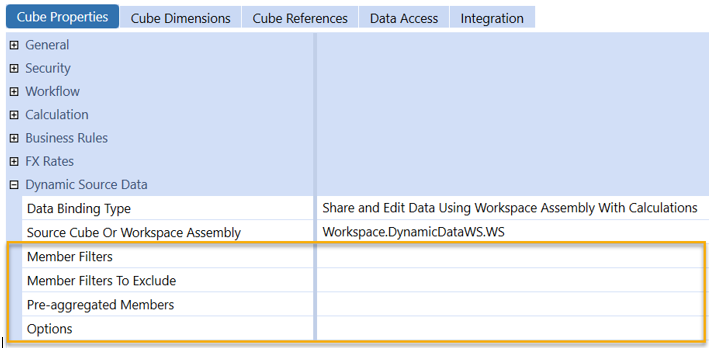A dynamic cube improves reporting query performance by filtering the results from source cubes into smaller data units.

Under Cube Properties, in the Dynamic Source Data section, you can set the following properties:
-
Member Filters: Determines which data is included in query results. Use a comma separated list to include only members in the lists. This can include multiple dimension types, member expansions, or single members. Leave the field blank to include all source data in query results.
-
Member Filters to Exclude: Determines which data is excluded in query results. Use a comma separated list to exclude members in the lists. This can include multiple dimension types, member expansions or single members. If it includes members from the Member Filters property, those members are excluded. Leave the field blank to exclude no data.
NOTE: You cannot use Data Unit dimensions in the Member Filters or Member Filters to Exclude properties (Entity, Time, Consolidation, Scenario).
-
Pre-aggregated Members: Determines whether to share or copy data from a parent member, source, to a base member, target. Set the top member to a Base member to pre-aggregate if the detail of a dimension is not needed. This alleviates repetitive calculations for the same number. For example:
UD1#Top=UD1#None,UD2#Top=UD2#None,UD3#Top=UD3#None,UD5#Top=UD5#None,
UD5#Top=UD5#None, UD6#Top=UD6#NoneNOTE: Ensure the base members are included in the Member Filters property and the parents are included in the Member Filters to Exclude property.
-
Options: Optional and variable settings that provide additional control when running a hybrid share or copy. Options are name-value pairs. Ensure the option names, definitions, and syntax are accurate and include any custom name-value pairs if a business rule is used to copy. Create a comma separated list if you use multiple options.
Capabilities
Dynamic cubes are used in several capacities such as consolidation, financial intelligence, and data unit calculation sequence adherence. Data unit dimensions can be targeted for shared data. Extensibility is supported.
Limitations
Dynamic cubes adhere to the following restrictions:
-
Data unit size and capacity are the same as a standard cube.
-
Cube design best practices should be followed.
-
Account, Flow, and UD parent members are calculated on-the-fly.
-
Text-based data integration is restricted to V#Annotations.



